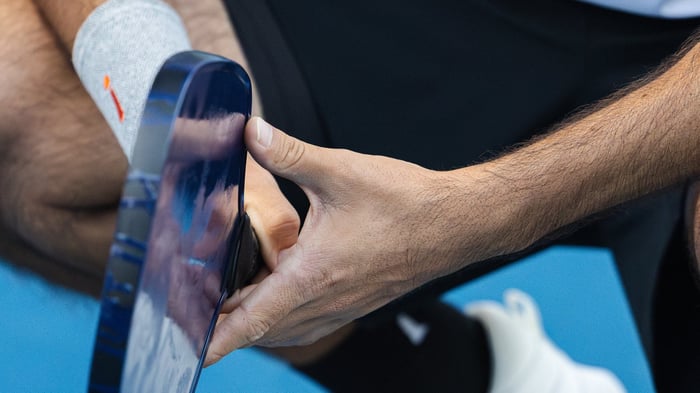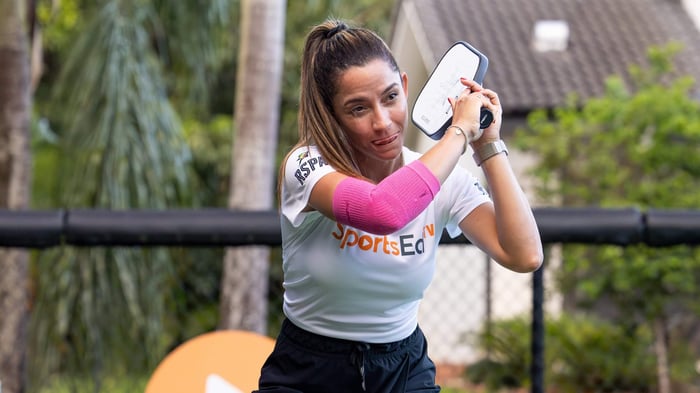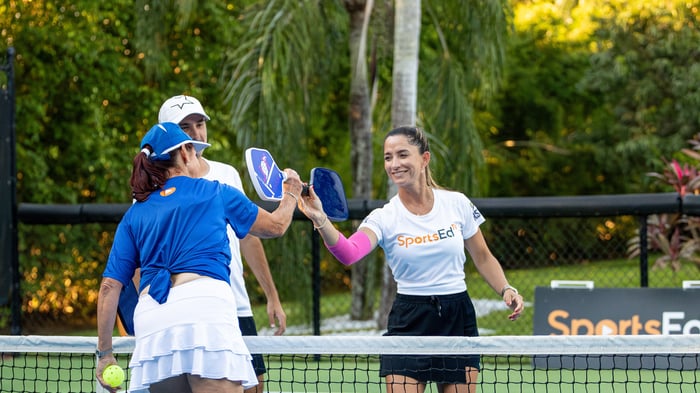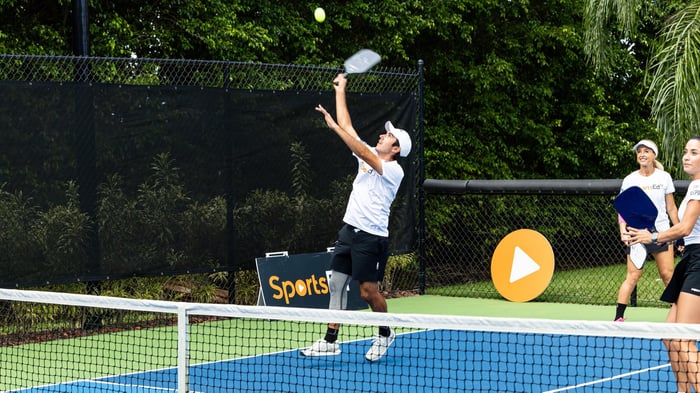Key takeaways:
Mastering the backhand spin dink adds precision, unpredictability, and control to your kitchen game, giving you a competitive edge during net exchanges.
Proper grip, stance, and paddle angle are essential for generating effective spin and maintaining consistency in your backhand spin dink technique.
Targeted practice drills and performance-ready gear can significantly enhance your ability to execute the backhand spin dink with confidence and accuracy.
What if one shot could transform your kitchen game from predictable to significantly more challenging to read? The backhand spin dink does exactly that, giving competitive players the control and unpredictability needed to dominate net exchanges.
According to pickleball experts, the backhand roll can be instrumental in gaining an advantage during neutral positions at the kitchen line, allowing players to exploit weaknesses and create scoring opportunities. When executed properly, this shot combines precision with deception, catching opponents off guard and shifting the momentum in your favor.
To harness this tactical advantage, mastering the backhand spin dink requires more than just understanding the mechanics. It demands the right grip technique, consistent practice drills, and awareness of common pitfalls that can derail your progress.
We’ll break down everything from paddle angle and wrist stability to strategic shot selection plus how the right gear from PB5star can support your technique and movement every step of the way.
What makes the backhand spin dink a must-have shot?
The backhand spin dink transforms ordinary kitchen exchanges into strategic battles where you hold the advantage. When you add spin to your backhand dink, you're not just hitting another soft shot, you're disrupting your opponent's timing and forcing them into uncomfortable positions.
According to research on dink variations, mixing up shot types keeps opponents guessing and unable to settle into a rhythm, which is exactly what competitive players need to gain the upper hand in close matches.
A well-executed topspin dink can reduce an opponent's reaction time, leading to rushed and weaker returns that open up attacking opportunities. This shot allows you to maintain strategic control while applying consistent pressure. It turns defensive exchanges into offensive setups.
Players who master the backhand spin dink develop a reputation for being hard to read and difficult to beat. The ability to vary spin, pace, and placement from the same basic motion keeps opponents off balance and prevents them from anticipating your next move.
This tactical control over the pace and flow of the game builds confidence in your kitchen play, knowing you have multiple options available regardless of the situation. When you can reliably execute this shot under pressure, you become the player who dictates the rally rather than simply responding to it.
Perfecting technique: Grip, stance, and paddle angle
When players ask what grip is best for a backhand spin dink, the answer consistently points to the continental grip. This grip provides the perfect balance between control and spin generation, allowing you to make quick adjustments during fast-paced kitchen exchanges.
The continental grip is the top choice for the backhand spin dink. It balances control and spin, allowing quick adjustments during fast-paced kitchen play. Used by many pros, this grip supports seamless transitions between forehand and backhand shots without changing hand position. It also improves wrist action, which is key for generating spin. While it may require more finesse to produce strong topspin, its versatility makes it ideal for adding unpredictability at the net.
Once your grip is set, your stance lays the foundation for consistent execution:
Stand with feet shoulder-width apart.
Keep knees slightly bent and weight on the balls of your feet.
Stay near the kitchen line, leaving space to step into your shots.
A slight sideways stance improves body rotation, giving you more control and power when brushing across the ball.
Your paddle angle at contact affects spin and consistency. Keep the face slightly open to brush up and across the ball, creating topspin and a fast dip after crossing the net.
For higher balls, close the paddle face slightly.
For lower ones, open it just enough to clear the net with spin.
Small adjustments in grip, stance, and paddle angle can elevate your backhand spin dink from functional to strategic.
How to add spin: Mechanics and drills for consistency
Creating effective spin on your backhand dink comes down to mastering the contact point and developing muscle memory through targeted practice. When players ask how do you add spin to a backhand dink in pickleball, the answer lies in understanding that spin generation happens through a controlled brushing motion at contact, which disrupts your opponent's timing and creates opportunities for attacking shots.
Master the contact brushing technique: Generate spin by allowing your paddle face to brush upward through the ball at contact, creating rotation while maintaining a low trajectory that forces opponents to hit up from below the net.
Perfect the Swoosh swing path: Visualize your paddle moving in a smooth arc, starting high, dipping down to contact, then lifting back up to help the ball clear the net, as demonstrated in professional lessons.
Maintain shoulder-driven motion with locked wrist: Keep your wrist stable throughout the swing and let your shoulder control the movement, preventing over-spinning while ensuring consistent contact and ball placement.
Practice targeted partner feedback drills: Work with a hitting partner to focus on paddle path consistency, calling out when your dinks have the right amount of spin, and asking for immediate feedback on ball rotation and placement effectiveness.
Use a ball machine for repetitive refinement: Set up a ball machine to deliver consistent feeds, allowing you to develop reliable swing mechanics without worrying about returning varied shots, as recommended by experienced players improving their backhand consistency.
Develop contact point awareness: Practice hitting balls at different heights and angles to build feel for where your paddle needs to meet the ball to create the desired spin and trajectory for each match situation.
Avoiding common mistakes when practicing the backhand spin dink
Mastering the backhand spin dink gives you a competitive edge, but common technical errors can undermine your progress and cost you points when it matters most. Smart players identify and correct these mistakes early to build the consistency that wins matches.
Control your wrist action: Overusing your wrist or swinging too aggressively compromises the finesse needed for effective spin dinks. Players who maintain proper wrist control often see accuracy improvements of up to 25%.
Prioritize footwork fundamentals: Poor positioning leads to rushed shots and inconsistent contact points. Neglecting your stance and movement patterns can reduce your ability to respond to spin shots by 30%, making you vulnerable during kitchen exchanges.
Perfect your paddle face angle: Keep your paddle face slightly open at contact, about 15-20 degrees from vertical to generate backspin while maintaining a low trajectory. Too closed and you'll hit the net; too open and the ball sails long or pops up for easy attacks.
Strike the balance with grip pressure: Squeezing the paddle too tightly creates tension that reduces feel and control, while a grip that's too loose compromises your ability to generate consistent spin. Maintain firm but relaxed pressure that allows for both power and precision.
Stay instinctive during play: Getting caught up in technical details during competitive situations creates hesitation and awkward shot execution. Let your practice sessions build the muscle memory that flows naturally when the pressure is on.
Play Better, Look Better
Mastering the backhand spin dink opens doors to more strategic, confident play, but meaningful connections form when you share that journey with fellow competitors. Organize group drill sessions focused on spin techniques, connect with other players who value continuous improvement, or join discussions about advanced strategies that can transform your overall game.
When you're ready to take your refined skills to the next level, having the right foundation makes all the difference. Explore the full performance-ready collection of PB5star and become part of something bigger than individual achievement, a community where skill development, style, and genuine camaraderie define what it means to truly love this game.
FAQs
How can you tell if your backhand spin dink is effective in a match?
Watch how your opponent scrambles to handle the rotation you've created on the ball. An effective backhand spin dink will cause the ball to dip quickly due to the topspin, making it challenging for opponents to return with precision.
What are the best drills to improve spin and consistency?
Focus on consistent repetition with exercises that emphasize hitting the ball's lower half to generate maximum rotation. Start by rehearsing the motion without contact to build muscle memory, then progress to live ball sessions with a training partner or ball machine.
How does paddle choice or apparel impact your performance with this shot?
Your paddle's surface texture and weight distribution directly affect rotation generation and touch during backhand dinks. Performance-ready apparel that allows unrestricted movement prevents interference with the brushing motion needed to create spin. Quality footwear with reliable traction helps maintain the balanced, athletic stance required for consistent execution.
When should you use the backhand spin dink versus a standard dink?
Use your backhand spin dink when you want to disrupt your opponent's rhythm or create an attacking opportunity. Reserve the standard dink for maintaining steady rallies when you're staying patient and waiting for a better opening.
How can you adapt the backhand spin dink for different playing styles or court surfaces?
On faster outdoor courts, dial back the rotation slightly to maintain better touch in windy conditions. Indoor courts with consistent conditions allow for maximum spin application, so you can be more assertive with your brushing motion and wrist action during group sessions or tournament play.







